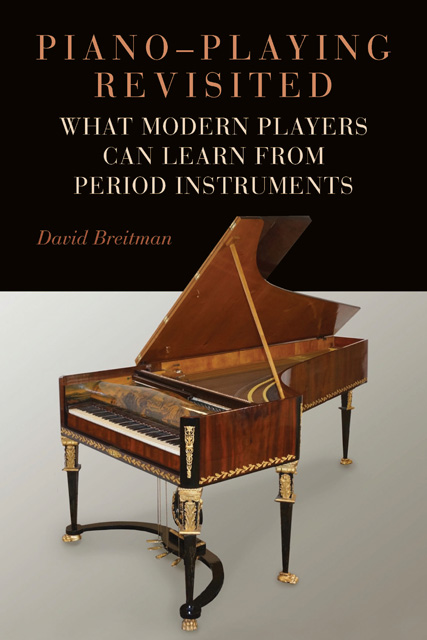Book contents
- Frontmatter
- Dedication
- Contents
- List of Illustrations
- Preface
- Acknowledgments
- 1 Music Making Then and Now
- 2 With Broad Strokes (An Overview)
- 3 The Early Days of the Piano: Haydn and Mozart
- 4 Beethoven and the Evolving Piano
- 5 Schubert
- 6 Chopin
- 7 The Clavichord
- Epilogue: Creativity in the Performance of Old Music
- Appendix: Overtone Structure of the Steinway and Walter, Compared
- Glossary of Terms
- Notes
- Bibliography
- Index of Works
- General Index
1 - Music Making Then and Now
Published online by Cambridge University Press: 17 January 2023
- Frontmatter
- Dedication
- Contents
- List of Illustrations
- Preface
- Acknowledgments
- 1 Music Making Then and Now
- 2 With Broad Strokes (An Overview)
- 3 The Early Days of the Piano: Haydn and Mozart
- 4 Beethoven and the Evolving Piano
- 5 Schubert
- 6 Chopin
- 7 The Clavichord
- Epilogue: Creativity in the Performance of Old Music
- Appendix: Overtone Structure of the Steinway and Walter, Compared
- Glossary of Terms
- Notes
- Bibliography
- Index of Works
- General Index
Summary
Pianos Then and Now: Variety and Standardization
Despite the rapid pace of technological change over the past century, the piano as we know it—a pinnacle of engineering at the end of the nineteenth century—has barely altered since then. For the first two centuries of the piano’s existence, however, change was the norm. The earliest pianos weighed little more than a harpsichord, about a hundred pounds; a modern concert grand weighs nearly a thousand. They grew steadily in range—from four octaves to more than seven—and in string tension, to produce ever more powerful sounds. The “harpsichord with soft and loud” (in Italian “gravicembalo col piano e forte,” hence pianoforte or fortepiano—piano for short) created by Bartolomeo Cristofori in Florence around 1700 was a delicate instrument, suitable for solo playing or for accompanying a singer (rather like a lute); today’s piano can compete with a symphony orchestra.
The basic nature of piano tone changed too. Classical-period instruments produced transparent sounds with a sharp attack and a quick decay; their clear articulation favored a “speaking” style of playing. Later ones had a longer-lasting singing tone, better suited to Romantic music. There was also great variety in their design, as hundreds of small workshops responded to ever-changing musical tastes with creativity and ingenuity.
But at the turn of the twentieth century, the piano industry consolidated and focused instead on the large-scale production of standardized instruments imitating the successful Steinway model.The new uniformity would have surprised musicians of the past. Franz Liszt personally endorsed various pianos with very different designs while Chopin reportedly preferred an Erard piano when he felt “out of sorts” and a Pleyel when he felt “in good form”;Today the Steinway type is still ubiquitous; its only challengers come from two opposing directions: a flood of innovation in the electronic arena, and the small-scale production of replica fortepianos.
Thanks to recordings, more and more music-lovers have heard those fortepianos. Malcolm Bilson’s set of the complete Mozart concertos from the 1980s was a watershed; since then, other adventurous players have explored an ever-widening range of repertoire using a variety of historical instruments, both antiques and replicas. Nevertheless, most pianists have never played anything but a Steinway-type piano, and the terminology we use reflects this reality.
- Type
- Chapter
- Information
- Piano-Playing RevisitedWhat Modern Players Can Learn from Period Instruments, pp. 1 - 7Publisher: Boydell & BrewerPrint publication year: 2021



